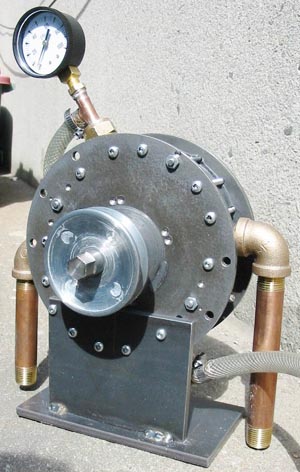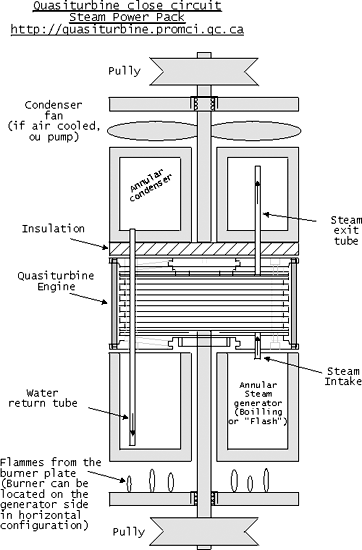Because it has to deal with distributed
energy technology,
small
steam co-generation is very demanding on efficiency and performance.
The Quasiturbine has exceptional efficient power modulation capability.
Quasiturbine Co-Generation
Efficiency Gains
Large scale utility co-generation is interesting, but the distributed small
scale co-generation is even more challenging and more naturally scaled to human
living style. This is the reason for this page about the Quasiturbine small
co-generation.
What is worthless for some may be valuable to others, or be use otherwise. This is the idea about
co-generation where the temperature cascade can be matched to several
applications, like turbine, Quasiturbine, drying process and finally district
heating... Everyone served from the same barrel of petrol! But this is somewhat
more difficult to accomplish the distributed way...
Steam power is staging what may prove to be the
biggest grass-roots comeback in the history of the industrial revolution! From micro-horsepower to
Giga-Watts, from microchips to motorcycles, and from wheel chairs to missions to
mars, STEAM POWER IS BECOMING PROMINENT IN VIRTUALLY EVERY INDUSTRY IN EVERY
COUNTRY OF THE WORLD. As fossil fuel will diminish, steam use will spread still
more...
Steam and Stirling Quasiturbine could not come at a better time.
Since the Quasiturbine is a pure expansion engine
(which the Wankel is not, neither most of other rotary engines),
it is well suitable as steam engine.
Since the Quasiturbine is an hydrostatic turbine (instead of aerodynamic),
it is also well suited for co-generation project with saturated steam. Quasiturbine Stirling is a unique tool for
small co-generation
energy recovery.
Moderate Temperature
In energy conversion equipments, working temperature differential is synonym
of efficiency, but could also mean more nitrogen oxide pollutants, and extra
cleaning cost. For this reason, moderate to low steam temperature are getting more and more
attention today. Unfortunately, conventional turbines require very specific high
steam quality and flow to be efficient, which make them almost useless with
moderate temperature steam, often near saturation.
The Quasiturbine steam engine does not produce vibration.

Quasiturbine pneumatic-steam model QT75SC (Without Carriage)
Usable with intake pressure as low as 20 to 50 psi!
This is where the Quasiturbine steam engine takes over, because it is not an
aerodynamic machine, and its efficiency is optimum at all pressure, load and
rpm. Furthermore small Quasiturbine of a Mega-Watt or less can be operated at the
same very low rpm of the generator, suppressing the need of costly gearboxes.
Quasiturbine Stirling works on two different temperature heat sinks, and offers
a unique recovery solution for small applications.
Saturated Steam
Since water requires an important quantity of latent vaporization heat (which is not generally recovered in the condenser or in the atmosphere open circuit), operation with saturated steam will always give low efficiency (5
- 10%), which call for cogeneration application. Even if the Quasiturbine
can accept saturated steam, it is not suitable from the energy efficiency
stand point, that this steam stays saturated during all the cycle.
In fact, in all expansion thermal machine (the Quasiturbine being one of the
most efficient), increase in thermal efficiency is always linked to steam
overheating since then one gets the same pressure effect with less molecules,
wherein making a substantial reduction in the quantity of water needed to be
vaporized (... and saving of the corresponding latent heat energy, while
some more calories are lost in the exhaust). For this reason, steam temperature supplement is
generally a good investment.
The Quasiturbine greatly reduces the energy station construction and operation cost,
improves substantially the risk and safety level, and reduces the law
constraints and the qualification needed from the employees involved.
QT Steam Modes
Pressurized steam is very dangerous and for this reason is well regulated, which is one of
the main obstacle to distributed steam systems. However, the steam Quasiturbine
offers alternative secure modes.
I - Conventional mobile steam engine (including saturated steam). From the basic
75 cc per chamber engine bloc,
a steam engine prototype has been built making use of 2 parallel expansion circuits
of 300cc per revolution each, for a total of about 17 cubic feet intake per minute at 1000
rpm. The concept integration and originality come from the fact that the
zero-vibration Quasiturbine
is located inside the boiler!

Conventional mobile compact Quasiturbine steam engine
II - Hot water injection engine (in-situ evaporation).
Because the Quasiturbine accepts saturated steam,
a positive way to bypass the intake steam flow limitations is
to use the Quasiturbine itself as evaporator.
In this case, the remote boiler becomes a simple hot water tank without evaporator,
and the pressurized hot water taken in a close loop at the base of the tank is brought to
the engine intake,
where droplets of water and oil are directly injected in the expansion chamber,
and consequently evaporated inside the Quasiturbine itself.
In this case, the latent heat of vaporization is also given to the engine by the close
pressurized hot water loop
via a pipe coil enclosing the Quasiturbine.
The exhaust steam goes to a conventional condenser and returns to the boiler.
This option also presents the advantage of requiring a much smaller boiler,
pipes of small dimensions, miniature control valves,
and permits potentially to reach higher rotational speed.
In the case of thermal solar systems, if the internal liquid reserve is large enough for
all the sunshine period,
this operation mode needs only one unique fill up at night!
III - Cold water injection engine.
This mode would definitively be unimaginable with conventional turbine, since
it reacts to the speed of steam flow, which must be pre-conditioned. In fact, if a burner heats the Quasiturbine engine bloc directly, there is no
need of a boiler any more
(The Quasiturbine acting simultaneously as the boiler, the over heater and the evaporator),
and one can then inject cold water (which will be preheated in the injector)
at a pressure superior to the internal maximum working pressure.
Ideal mode for thermal solar concentrator heating directly the Quasiturbine engine bloc !
(This mode is equivalent of using the Quasiturbine engine bloc as a "flash steam
generator")
(Notice that a remote heat source could use an un-evaporating fluid like oil or
liquid sodium to transfer heat to the engine bloc).
Combined Cycle
Quasiturbine HCCQT? Very
high efficiency gas turbine electrical power plants use a Combined Cycle Gas
Turbine CCGT to reach efficiency of about 55%. In a
small combine
Quasiturbine power plant, there could be also two cycles. In the first cycle, a
Quasiturbine would be used as an internal combustion gas engine to
generate electric power. The sensible heat from the first cycle would then be
run through a heat exchanger to generate steam in a boiler for the second cycle.
Because of similar Quasiturbine's unique ability to run on combusted fuel and
steam, in the second cycle, steam would provide motive force to an other
Quasiturbine, thereby increasing overall fuel efficiency.
Furthermore, the Quasiturbine
center being empty, the internal combustion (IC) and Steam Quasiturbines can be
on the same shaft, with a simple ratchet coupling, and the torque will be
cumulative on one single electrical generator! The interesting point (from a
capital cost standpoint) is that it does not require two different systems, as
with the natural gas turbine and the steam turbine do with a CCGT.
Thus, in principle, one could have a Combined Cycle Quasiturbine. The
fuel efficiency would probably be less than a true CCGT (55%)
but more than the Quasiturbine alone (33%) which can run at higher internal
temperature because of early adiabatic expansion mechanical conversion.
QT Stirling - Heat Pumps
For small unit, the combustion cycle
could be combined with the Quasiturbine-Stirling cycle, which with a spoon of
water can also work as a closed circuit steam engine.
Some heat can be stored for later use. The Quasiturbine Stirling acts as
heat pumps for this purpose, or for passive geothermal using the immense stable
underground heat sink where heat can be stored or
removed at convenient cost through heat pumps.
Applications
Such small and efficient Quasiturbine steam engine makes mobility possible.
Thermal solar steam could drive a Quasiturbine. Solar concentrator could
directly heat up a Quasiturbine engine bloc, which would act as evaporator,
super-heater and motor! It could also be used for small geothermal or industrial heat process.
At home, combine electricity and heating would be possible from several
sources, sometimes with complementary higher temperature source.
Quasiturbine Stirling could be made cylindrical and be inserted directly into
the chimney for optimum heat recovery.
Engine Exhaust Heat Recovery:
By placing a hot Quasiturbine into or around an engine exhaust pipe, and
injecting pressurized hot water (steam keep in the liquid state for better heat
transfer), some heat can be recovered into mechanical energy. Stirling and short
steam circuit Quasiturbine could do similarly! Same technology could apply to:
Industrial exhaust gases heat recovery
industrial furnace heat recovery
Industrial process heat recovery
Chimney or stack heat recovery
Waste heat recovery
Solar heat recovery
Geothermal heat recovery
Thermal nuclear heat
More Technical
Why Quasiturbine steam and solar energy?
Quasiturbine Rotary Expander
Quasiturbine - Comparative efficiency with other engines
International Association for the Advancement of Steam Power
Quasiturbine Thermal Stirling
Rotary Engine (Sterling)
|